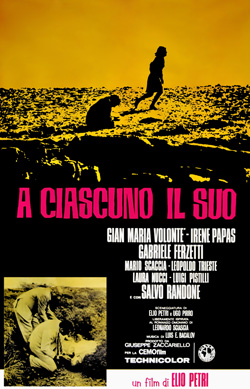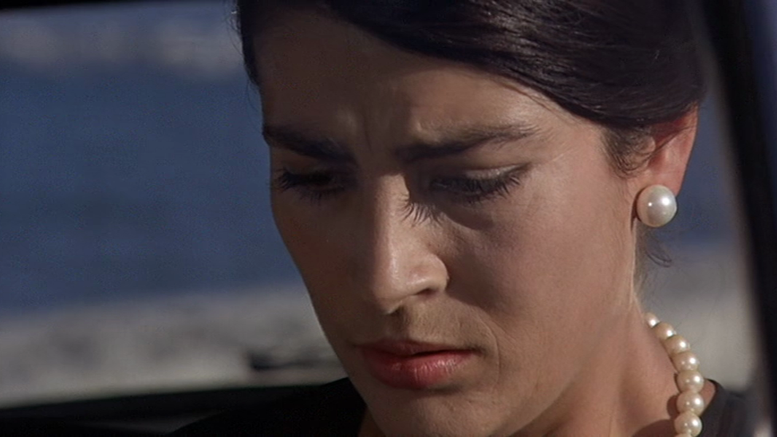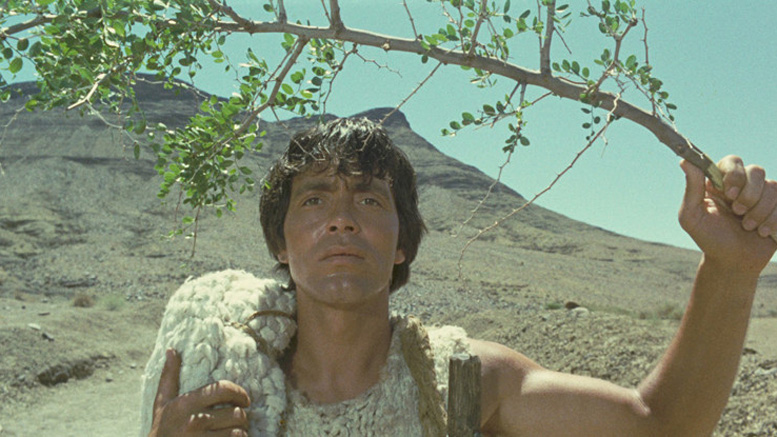Aka A ún matamos a la antigua (Argentina), A chacun son du (France), Zwei Särge auf Bestellung (West Germany), A ciascuno il suo (It)
Italy
1967
Produced by Giuseppe Zaccariello for Cemofilm
Director: Elio Petri
Story: Based on the novel ‘A ciascuno il suo’ by Leonardo Sciascia
Screenplay: Elio Petri, Ugo Pirro
Cinematography: Luigi Kuveiller {Technicolor}
Music: Luis Enrique Bacalov, the song ‘Pour r?ver l’hiver’, based on the text by Rimbaud
Editor: Ruggero Mastroianni
Art director: Sergio Canevari
Cameraman: Danilo Desideri
Release dates & running times: Italy (22/02/67), France (67, 93 mins), West Germany (22/09/67, 93 mins)
Filmed: Exteriors shot in Palermo
Italian takings: 497.000.000 lire
Cast: Gian Maria Volonté (Paolo Laurana), Irene Papas (Luisa Roscio), Gabriele Ferzetti (Rossello), Mario Scacchi (Sant’Amo curator), Laura Nucci (Paolo’s mother), Salvo Randone (Professor Roscio), Luigi Pistilli (Arturo Manno), Leopoldo Trieste (the communist deputy), Giovanni Pallavicino (Ragana), Franco Tranchina (Dr. Antonio Roscio), Anna Rivero (Anna Manno), Luciana Scalise (Rosina), Orio Cannarozzo (a police inspector), Carmelo Oliviero (the archpriest, Luisa’s uncle), Carlo Ferro, Tanina Zappala, Valentino Macchi, Michele Vannucci
Uncredited: Al Cascino (a policeman)

After all the high-concept exuberance of The Tenth Victim, We Still Kill the Old Way saw Petri move from sci-fi to the crime genre and, stylistically, marked a return to a more subtle, low-key approach. Manno (Luigi Pistilli), a pharmacist in a small Sicilian town, receives a series of anonymous death threats. He shrugs them off, but his nonchalance proves misguided when his friend Dr. Roscio (Franco Tranchina) and he are murdered whilst out hunting. It is assumed that the killer was an aggrieved husband (Manno had been a notorious philanderer) and before long the peasant brothers and father of his teenage mistress are arrested for the crime.
His friend Paolo (Gian Maria Volonté), a professor who works in Palermo, is unconvinced. The three suspects are all illiterate, so how could they have written the death threats? He manages to convince a respected lawyer, Rossello (Gabriele Ferzetti), to act as counsel for the defence, and in the meantime starts investigating matters for himself.
With the help of Rossello’s sister, Luisa (Irene Papas), he gradually becomes convinced that Roscio was the actual target of the assassination, and that his friend was merely an unfortunate witness. The Doctor, it appears, had been compiling a dossier that would implicate a prominent (but unnamed) local figure in all manner of illegalities, including murder.
As a murder mystery, it’s not too hard to work out exactly who the guilty party is here. It’s far harder to figure exactly what’s going on most of the time, with the whole plot becoming extremely convoluted as everything progresses. However, Petri isn’t overly concerned with the thriller aspects of the story. He is more interested in examining the way that the unstated Sicilian ‘customs’ succeed in maintaining the status quo by ensuring that the powerful remain untouchable. As is often the case with filmmakers of strong convictions, his message does get in the way of the narrative flow. This shouldn’t be overplayed, however, and in many ways We Still Kill the Old Way remains one of his most effective films.
It is fantastically made. Luis Enrique Bacalov’s soundtrack is superb, despite there being one particularly cheesy upbeat ditty that seems to appear every time something depressing happens. Luigi Kuveiller’s cinematography is first class, and the opening sequence – in which the camera prowls over the imposing cliffs and down into the town square – is literally awesome.
For those who are more familiar with Gian Maria Volonté’s villainous turns in Leone’s Fistful of Dollars (Per un pugno di dollari, 64) and For a Few Dollars More (Per qualche dollaro in più, 65), his performances in this and subsequent Petri films will come as something of a revelation (6). He plays a timid character, someone who doesn’t really understand the place in which he grew up because his ‘head was always in the clouds’. There’s always the feeling, however, that below this civilized veneer hides a distinctly less cultivated animal – as becomes especially clear in the scenes in which he assaults the unwilling Irene Papas. Another Leone actor, Gabriele Ferzetti, who played the crippled railway man in Once Upon a Time in the West (C’era una volt ail West, 68), also turns in an impressive performance.

(6) Milanese actor Gian Maria Volonté began his career in the theatre as a member of the Accademia d’Arte Drammatica in the early 1950s. After receiving huge acclaim for his performance in an adaptation of The Idiot in 1959, he also started appearing on television and in films ranging from Cottafavi’s fun peplum Hercules Conquest of Atlantis (Ercole alla conquista di Atlantide, 61) to Nanni Loy’s critically respected The Four Days of Naples (Le Quattro giornate di Napoli, 62). It was in Spaghetti Westerns, though, that he first found fame, appearing in classics of the genre such as Leone’s Fistful of Dollars (Per un pugno di dollari, 64) and For a Few Dollars More (Per qualche dollari in più, 65), Sergio Sollima’s Face to Face (Faccia a faccia, 67) and Damiano Damiani’s A Bullet for the General (Quien sabe, 66). This success allowed him to cherry-pick roles more attuned to his political convictions, and it wasn’t surprising that he gravitated to Petri’s orbit. In the late sixties and seventies he also appeared in many other classics of European cinema, including Carlo Lizzani’s Bandit’s of Milan (Banditi a Milano, 68), Jean-Pierre Melville’s The Red Circle (Le cercle rouge, 70) and Francesco Rosi’s Christ Stopped at Eboli (Cristo si è fermato a Eboli, 79), before his death in 1994.
